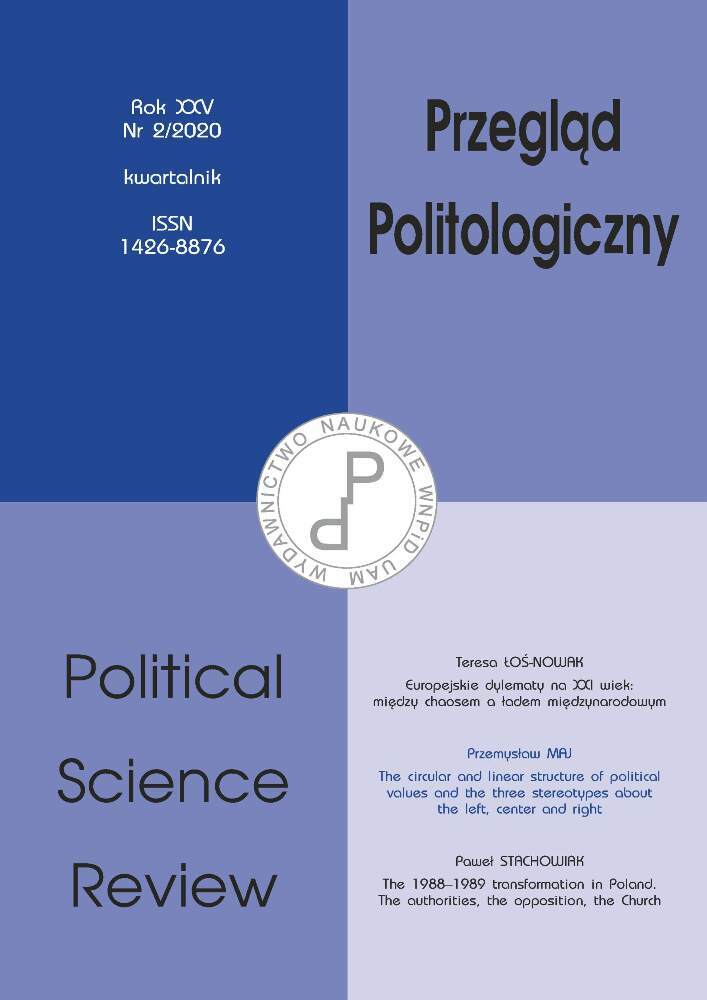Abstract
The purpose of the article is to determine the factors that influenced the process of the development and implementation of Lithuania’s foreign and domestic policies in the field of migration within the framework of the EU rules (dispositive and imperative) and identify those factors that may have a similar effect on the stability of migration processes in Ukraine with regard to its accession to the EU. The task is to determine the problems (negative preconditions and consequences) of the migration sector based on the analysis of more than a decade of experience of Lithuania as an EU member and the influence of the latest European crisis. Lithuania’s strategies with regard to the following issues are relevant to Ukraine’s European integration aspirations: the migration crisis in the EU, in terms of overcoming it through a “relocation plan;” and the integration of the national minorities of Lithuania, including the Roma minority, into the country’s civil society. Furthermore, some of Lithuania’s efforts actively support Ukraine’s European integration aspirations, such as the attempt to model how current problems can be predicted and resolved by Ukraine if it acquires EU membership, on the basis of Lithuania’s experience, which has relevance for Ukraine due to the fact that Lithuania and Ukraine – along Poland and other countries – inherited the Soviet system of government, and because of their similar mentality and current bilateral relations. After the Ukrainian crisis in 2014, and the subsequent EU migration crisis in 2015, Lithuania reviewed its national policy priorities taking into account that its state boundary is the part of the EU boundary, without any “buffer zone.”
References
Action Plan for Roma Integration into The Lithuanian Society for 2015–2020, approved by the Minister of Culture of the Republic of Lithuania Order No ĮV-48 of 29 January 2015 (amended by the Minister of Culture of the Republic of Lithuania Order No ĮV-273 of 28 April 2015, https://Ec.Europa.Eu/Info/Sites/Info/Files/Lithuania_National_Strategy_2015-2020_En.pdf, 11.09.2019.
Action Plan for Roma Integration into The Lithuanian Society for 2012–2014, https://ec.europa.eu/info/files/lithuania-national-strategy-2012-2014_en, 11.09.2019.
An EU Framework for National Roma Integration Strategies up to 2020 (5.4.2011.COM(2011) 173 final), Communication from the Commission to the European Parliament, the Council, the European Economic and Social Committee and the Committee of the Regions, https://eur-lex.europa.eu/legal-content/EN/TXT/PDF/?uri=CELEX:52011DC0173&from=en, 18.09.2019.
Arlauskas D. (2019), On the “pitfalls” of immigration from third countries. Immigration to Lithuania increases: who are the immigrants?, 27.06.2019, “Lithuanian Tribune”, https://lithuaniatribune.com/immigration-to-lithuania-going-up/, 17.08.2019.
Brunovskis A., Sønsterudbråten S. (2017), Asylum, integration and irregular migration in Lithuania: Policy and practice at the edge of the European Union, FAFO social science research foundation, https://www.fafo.no/images/pub/2017/20631.pdf, 17.08.2019.
de Haas H. (2009), Migration systems formation and decline. A theoretical inquiry into the self-perpetuating and self-undermining dynamics of migration processes, “International Migration Institute Working Paper”, no. 19, University of Oxford.
EU Heads of State agree to step up the fight against illegal migration (2018), “Press Service of the President of Lithuania”, 29.06.2018, https://www.lrp.lt/ru/press-centr/soobscenija-dlja-pressy/glavy-stran-es-dogovorilis-usilit-borbu-s-nelegalnoi-migraciei/30340, 25.11.2019.
European Solidarity: A Refugee Relocation System (2015), European Commission, https://ec.europa.eu/home-affairs/sites/homeaffairs/files/what-we-do/policies/european-agenda-migration/background-information/docs/2_eu_solidarity_a_refugee_relocation_system_en.pdf, 2.09.2019.
Fourth Opinion on Lithuania (2018), Advisory Committee on the Framework Convention for the protection of national minorities (ACFC/OP/IV(2018)004), https://Rm.Coe.Int/4th-Advisory-Commitee-Opinion-On-Lithuania-English-Language-Version/1680906d97, 29.08.2019.
Geddes A., Scholten P. (2016), The politics of migration and immigration in Europe, 2nd Edition, SAGE Publications, London.
Hordecki B. (2019), Language Policies as an Instrument of Shaping and Rhetoricizing Mutual Relations in the Post-Soviet region, “Przegląd Politologiczny”, vol. 2, DOI: 10.14746/pp.2019.24.2.6, http://przeglad.amu.edu.pl/wp-content/uploads/2019/06/pp-2019-2-06.pdf, 30.11.2019.
Hungary to block Ukraine’s NATO membership over language law, “Reuters”, https://www.reuters.com/article/us-ukraine-nato-hungary/hungary-to-block-ukraines-nato-membership-over-language-law-idUSKBN1Y823N?feedType=RSS&feedName=worldNews.
Jakučionis S. (2018), As EU changes asylum system, Lithuania continues disapproval of migrant quotas, 26.01.2018, “Baltic News Service”, https://en.delfi.lt/eu/as-eu-changes-asylum-system-lithuania-continues-disapproval-of-migrant-quotas.d?id=77005205, 21.11.2019.
Kuczyńska-Zonik A. (2017), The securitization of national minorities in the Baltic States, “Baltic Journal of Law & Politics”, vol. 10, no. 2.
Lithuania: EU resettlement programme triggers national social inclusion challenges, 8.02.2016, “European web site of integration”, https://ec.europa.eu/migrant-integration/news/lithuania-eu-resettlement-programme-triggers-national-social-inclusion-challenges, 25.11.2019.
Massey Douglass S., Arango J., Hugo G., Kouaci A., Pellegrino A., Taylor J. E. (1993), Theories of international migration: a review and appraisal, “Population and Development Review”, 19(3).
Minister of Internal Affairs of Lithuania Misuunas E. (2018), Relocation of Refugees to Lithuania Slows Down Due to Lack of Documents from Greece and Italy, 07.09.2018, “Lithuanian Courier”, no. 4, http://www.kurier.lt/ministr-peremeshhenie-bezhencev-v-litvu-buksuet-iz-za-nexvatki-dokumentov-ot-grecii-i-italii/, 21.11.2019.
National Threat Assessment (2019), State Security Department of the Republic of Lithuania, https://www.vsd.lt/wp-content/uploads/2019/02/2019-Gresmes-internetui-EN.pdf.
Perring R. (2016), Desperate EU urges nations to accept migrant quotas as Baltic states close borders, 9.08.2016, “Express”, https://www.express.co.uk/news/world/698025/Baltic-states-EU-migrant-quote-Latvia-Lithuania-Estonia, 12.08.2019.
PI Roma Community Centre Civil society (2018), Monitoring report on implementation of the national Roma integration strategies in Lithuania, European Commission B-1049 Brussels.
Poviliunas A. (2011), Promoting Social Inclusion of Roma in Lithuania, A Study of National Policies, European Commission DG Employment, Social Affairs and Inclusion, https://www.gitanos.org/upload/44/11/synthesis_report_2011-2_final_3_1_.pdf.
Prawo Ukrainy co do zabezpieczenia funkcjonowania języka ukraińskiego jako języka państwowego, (2019), “Dziennik Ustaw Rady Najwyższej” (Vidomosti Verhovnoi Rady Ukrainy), no. 21.
Second Opinion on Lithuania (2006) (ACFC/SR/II9(2006)007), Advisory Committee on The Framework Convention for The Protection of National Minorities, http://tandis.odihr.pl/explore?bitstream_id=22644&handle=20.500.12389/19771&provider=iiif-image#?c=0&m=0&s=0&cv=9&xywh=-1332%2C-200%2C5132%2C3897, 29.08.2019.
The largest foreign community in Lithuania is Ukrainian, 19.01.2019, “Delfi.lt.”, https://ru.delfi.lt/news/live/krupnejshaya-obschina-inostrancev-v-litveukrainskaya.d?id=80142265, 11.08.2019.
Third Opinion on Lithuania (2013) (ACFC/OP/III (2013)005), Advisory Committee on The Framework Convention for The Protection of National Minorities https://rm.coe.int/CoERMPublicCommonSearchServices/DisplayDCTMContent?documentId=0900001680099360, 29.08.2019.

